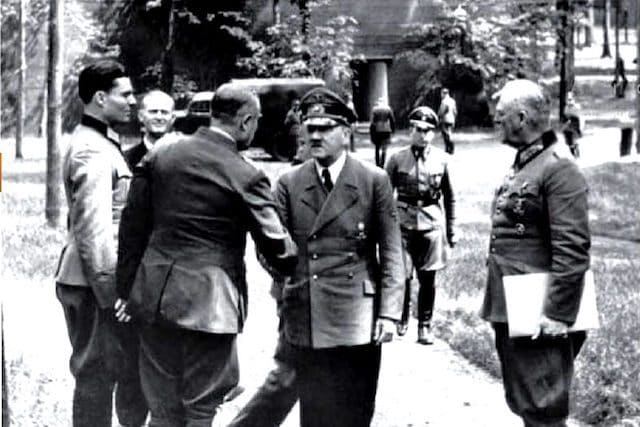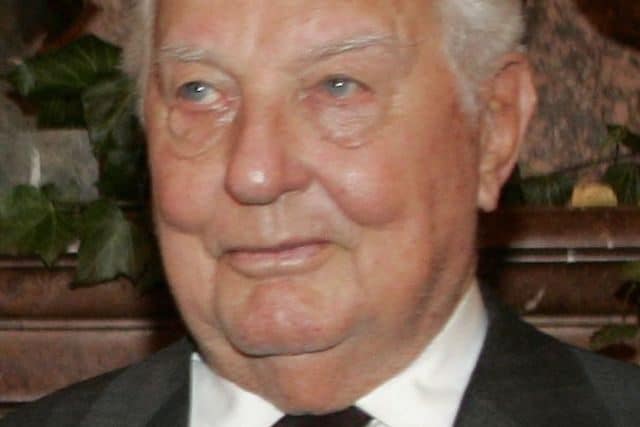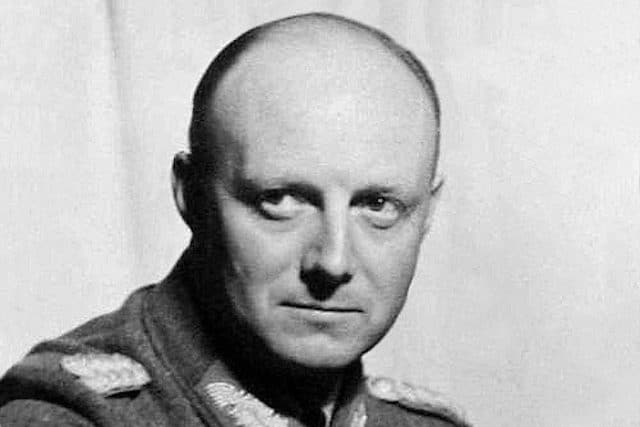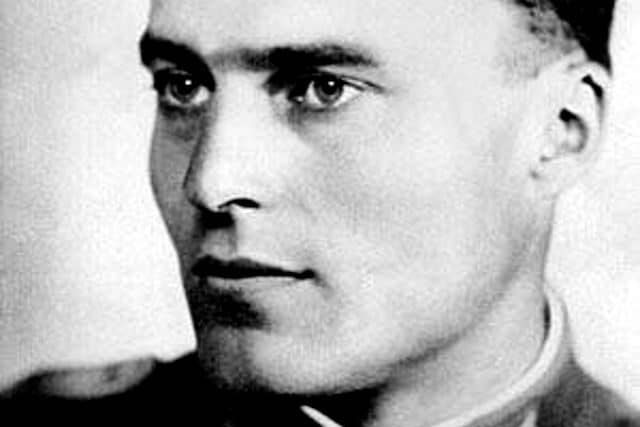On July 20, 1944, Colonel Claus von Stauffenberg placed a case filled with explosives as close as he could to Adolf Hitler in his military headquarters known as the Wolf’s Lair. It was the crux of a coup that became known as Operation Valkyrie. The bomb would mangle the Fuhrer’s arm to the point of paralysis but fail to kill him, lengthening the war by nearly a year. As a result of taking such a bold step in overthrowing one of the most harmful regimes in human history, many have elevated Claus von Stauffenberg to being roughly the equivalent of Oskar Schindler in terms of a Good German willing to put it all on the line. It especially helped that von Stauffenberg became a martyr who reportedly devoted his last words to his devotion to a Free Germany.
What was the truth about this plan? How far did it reach? Who were the other conspirators? What were their fates? What would likely have happened to the World if their plot had succeeded? Join us in exploring the answers to these questions.
10. Not a Hasty Plan

It would likely be assumed that Operation Valkyrie was in response to how the Normandy Invasion signaled to many in the German High Command that the war was hopeless. After all, the bombing did occur only a little over a month after D-Day. This is, of course, a more Western Powers-centered view since it doesn’t take into account all the progress the Soviet Union had already made in their drive to Berlin, but it’s wrong in a more fundamental view.
As early as 1942, von Stauffenberg had hatched the plan that would become Operation Valkyrie and began laying the groundwork for it. That was especially notable in that the Reich’s military hadn’t yet suffered the defeats that would doom them, such as Stalingrad. The SS had been getting wind of it before the end of 1943 and were naturally making arrests and forcing conspirators out of office. Among them was Admiral Wilhelm Canaris, which was quite a feat of detective work since his position made him head of the Abwehr, the Reich’s spy network.
9. The Destruction of the SS

Although it was the only part that anyone even attempted to implement, the bombing of the Wolf’s Lair was only the intended first step of Operation Valkyrie. While the six core conspirators of the coup were high in the chain of command, they still felt they would need to destroy the most devotedly Nazi section of the armed services to start a new government and make peace. That meant the Schutzstaffel (“Protective Echelon”) that were supposedly serving as the Furher’s bodyguards. Considering that the organization numbered roughly 800,000 (though large portions were stationed at the various fronts), what force in the Reich could be hoped to take them down?
The answer was the reserve soldiers known as the Home Army that were stationed throughout Germany that were intended to keep the peace at home while a vast portion of the able-bodied men were occupying foreign lands. They had become essentially necessary in light of Allied bombing campaigns and the chaos each of those left in their wake. Bolstered by such units as the 1,200 veterans of the Eastern Front under the command of Phillip von Boselaeger, they would surely have stood a fighting chance against soldiers the SS could throw at them. More on this in a moment.
8. The Suicide Bomber Fashion Model

Claus von Stauffenberg’s stroke of placing two pounds of plastic explosives (half the original intended amount) near the Fuhrer was bold in a way few men would have managed, but at least a couple of his conspirators were willing to outdo him. One of the most enthusiastic was Ewald-Heinrich von Kleist, who was a 22-year-old lieutenant when he volunteered to wear a bomb vest while meeting with Hitler, a plan he even discussed with his father. His father told him if he didn’t take the chance he’d “never be happy again in his life.” Of all things, his opportunity was to model a new uniform for the dictator.
Although von Kleist’s first attempt was foiled when Hitler canceled the modeling session, he was also willing to be the second man to bring a bomb into the Wolf’s Lair, but von Stauffenberg ended up going it alone. Von Kleist was arrested for being part of the plot but, to even his surprise, was released. After the war he became a highly distinguished organizer of diplomatic meetings, including earning the Medal for Distinguished Public Service in 1991 even though it’s an American award. The man who’d been willing to kill himself for his country ended up living the longest of anyone involved in Operation Valkyrie, passing away in 2013 at age 90.
7. The Foiled Attempts

While the July 20 bombing is the only one a person with a passing familiarity with WWII is likely to have heard about, in the two years after von Stauffenberg conceived of the coup there were numerous other attempts on Hitler’s life by his own military. One even predated von Stauffenberg’s decision to take part in it. In the summer of 1941, even though the Reich was at the height of its power, Maj. General Henning von Treskow planned with three of his staff members to arrest the Fuhrer while he was visiting them at Borisov in the Soviet Union, an attempt so feeble that it was literally defeated by the presence of the SS.
In March 1943 there was a more concerted effort, likely because the situation had decisively turned against the Wehrmacht on the Eastern Front at Stalingrad. While Hitler was stopping in Smolensk, Treskow smuggled an explosive in a parcel with some liquor bottles onto Hitler’s plane, only to be stopped by defective fuses. A week later Treskow’s gloves came off when on March 21 he sent Colonel Freierr von Gersdorff to kill the dictator during an inspection of an art gallery by means of suicide bombing. Von Gersdorff complied, and was within striking distance of the Fuhrer with bombs set with ten minute chemical fuses in his pockets… only to be foiled when Hitler left two minutes early, leaving von Gersdorff to douse the fuses in frustration. After such a record of bungled attempts it becomes not so much disappointing that the July 20 attempt failed but surprising that it came anywhere close to succeeding.
6. Not So Free Germany

The stated aim of Operation Valkyrie was a “Free Germany,” which brings to mind the notion of either democracy or at least a republic. That very likely was not the case. Claus von Stauffenberg was a monarchist through and through, and personally he was an aristocrat. He wasn’t alone, and other high ranking members of the coup included finance minister Johannes Popitz and Baron von Kleist, who’d even been assuring British representatives that overthrowing Hitler would mean a return to German monarchy as far back as 1938.
It certainly doesn’t necessarily mean that their intention was just to swap out Hitler’s dictatorship for their own, but it does add moral shading to understanding the conspirators.
5. The Treacherous Friedrich Fromm

Although the natural assumption was that most people executed by Hitler in the wake of the attempted coup were the result of Hitler’s brutal vindictiveness, von Stauffenberg was done in by his own conspirators. Friedrich Fromm, head of the aforementioned Home Army, was chosen by the conspirators to be in charge of arresting the SS after being appointed head of the army. Instead, when word that Hitler survived got out, Fromm ordered the execution of his co-conspirators in an attempt to save his own skin. While it did result in von Stauffenberg being executed the same day as his assassination attempt, it did not save Fromm.
Interestingly, Fromm wasn’t charged by Himmler with treason after it was found that he was part of the plot. He was charged with cowardice for not doing more to stop von Stauffenberg, not the sort of legal maneuvering that would intuitively be necessary in a dictatorship purging treasonous elements during a total war. The most ordering the execution of his co-conspirators achieved for him was that he was put to death by a firing squad on March 19, 1945 instead of the more vicious fate most of his associates suffered.
4. Thousands of Executions

Accounts vary on how many conspirators were at the heart of the conspiracy. By some counts it was a circle of two hundred. Accounts are consistent on the fact of how many were put to death: 5,000. It wasn’t at all restricted to people that were suspected of a connection to the plot. In the wake of the July 20 Plot, Heinz Guderian and Himmler began a loyalty campaign of checking every high ranking officer suspected of not being sufficiently loyal to Nazism, and in many cases putting them before show trials. The luckier ones among them were those offered the choice of a painless suicide, most famously Field Marshal Erwin Rommel.
However much Hitler despised Jews, Slavs, homosexuals, and other victims of concentration camps, his hatred for even the relatives of people connected with Operation Valkyrie reached a passionately sadistic level. He not only had many of those found guilty executed by hanging them from meat hooks with piano wire (thus ensuring slower strangulation with cut throats instead of quick death by broken necks as a gallows would ideally provide). He had the executions filmed and amused himself by watching them.
3. Lingering Resentment

Because the Nazi regime brought Germany to ruin and disgrace in the eyes of the world for inflicting millions of war crimes across Europe, Africa, and Asia, the intuitive belief would be that after Germany surrendered the July 20 plotters would be looked upon as martyrs who’d sacrificed everything in an attempt to save the Fatherland. Those family members who survived were primarily ostracized, only able to socialize with each other after the war despite Allied efforts to “de-Nazify” Germany. Even the British government didn’t have a very favorable opinion of the July 20 plot, claiming it had only been an effort to seize power instead of end the war. It also didn’t help that in 1949 and 1954 Amnesty laws were passed in Germany which effectively pardoned hundreds of thousands of Nazi war criminals, reinforcing the notion that the regime had been a legitimate one.
One of the primary efforts that changed public opinion was the 1959 bestseller by Fabian von Schlabrendorff Officers Against Hitler. The book clarified the rationale behind the coup and gave accounts from the survivors. It was hardly an overnight process. It wasn’t until 1967 that the effort received any official memorial. Even as late as 1970 a poll found that only 39% of the population viewed Operation Valkyrie positively. Today the effort is further honored by having members of the German military swear their oath of service on July 20. And of course, having a Tom Cruise movie made about the plot helped give it a more favorable view, too.
2. Foiled by a Floor

While the generally accepted narrative is that the reason Hitler survived with nothing but an injured arm and ruined pants was that one of those present had moved the bomb slightly away from him and behind one of the table legs, there was another factor that was at least as significant: The meeting that was bombed took place in a weakened room. See, if it had taken place in one of the Wolf Lair’s reinforced concrete bunkers, then the shock waves wouldn’t have been forced to travel through the air and into the bodies of the targets. The fact the meeting was moved to a room that not only had a wooden floor but also by windows that released shock force had more effect on those kinetic forces than a table leg.
Someone who didn’t realize the physics of the situation was Claus von Stauffenberg. He lingered outside the bombed building long enough to see the detonation. When he saw the windows blown out, he completely misjudged the implications of that and went ahead with the plot, traveling to his headquarters and issuing orders for buildings to be captured in accordance with the plan. It’s hardly certain that if he had known how much less effective his bomb was than he’d planned that he would have been able to escape execution, but it certainly could have provided a vital head start.
1. Not Such a Loss Long Term

While it naturally seems like a huge missed opportunity for humanity that countless people weren’t spared the last few seasons of the war with millions of deaths in captivity, historians such as Roger Moorhouse have argued that circumstances at the time indicated that even in some reverse Man in the High Castle-esque scenario, it wouldn’t have been so good for Germany. After all, a large part of the myth that let the Nazis rise to power was claiming that they’d lost WWI because of Jews. So for von Stauffenberg to literally initiate the coup of Hitler’s paranoia would have completely validated Nazi conspiracy theories and likely led to the rise of a new equivalent to the Reich down the line, something to make the fringe movement that is the Neo-Nazis of today look very small indeed.
For one thing, the Allies had rejected every form of peace overture that wasn’t unconditional surrender, something the new government would be very unlikely to merely accept by laying down their arms but would have left their armies uncoordinated and demoralized in the face of the Red Army. It would have left a former Reich and much of Europe that could fall under Soviet boots under some pretext by Stalin (who hadn’t needed much excuse to attempt to annex Finland, among other nations) and leave the world with less an Iron Curtain than an Iron Continent. We can tell you plenty about just how bad that could be. Given that Churchill and company were willing to orchestrate a war with the Soviet Union under even the relatively favorable conditions they ended with as it was, it’s not even a stretch to assume it would have meant a war between the former Allies before long.
Dustin Koski is also the author of the occult horror novel Not Meant to Know.